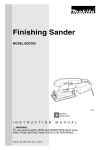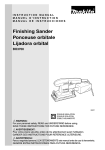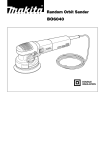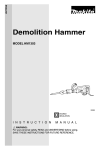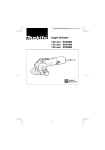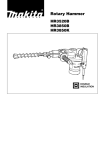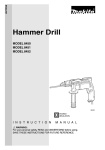Download Makita BO3700 Specifications
Transcript
Finishing Sander BO3700 DOUBLE INSULATION SPECIFICATIONS Model BO3700 Pad size .................................................................................................................................... 93 mm x 185 mm Abrasive paper size ................................................................................................................... 93 mm x 228 mm Orbits per minute ..................................................................................................................................... 10,000 Overall length ..........................................................................................................................................254 mm Net weight .................................................................................................................................................. 1.4 kg • Due to our continuing program of research and development, the specifications herein are subject to change without notice. • Note: Specifications may differ from country to country. Intended use The tool is intended for the sanding of large surface of wood, plastics and metal materials as well as painted surfaces. Power supply The tool should be connected only to a power supply of the same voltage as indicated on the nameplate, and can only be operated on single-phase AC supply. They are double-insulated in accordance with European Standard and can, therefore, also be used from sockets without earth wire. For European countries only Noise and Vibration The typical A-weighted noise levels are sound pressure level: 71 dB (A) sound power level: 85 dB (A) – Wear ear protection. – The typical weighted root mean square acceleration value is 3 m/s2. 1 EC-DECLARATION OF CONFORMITY We declare under our sole responsibility that this product is in compliance with the following standards or standardized documents, HD400, EN50144, EN55014, EN61000 in accordance with Council Directives, 73/23/EEC, 89/336/EEC and 98/37/EC. Yasuhiko Kanzaki CE 2000 Director MAKITA INTERNATIONAL EUROPE LTD. Michigan Drive, Tongwell, Milton Keynes, Bucks MK15 8JD, ENGLAND 2 4 1 3 2 5 1 2 8 6 9 3 7 3 4 13 11 12 10 5 6 7 3 Symbols The following show the symbols used for the tool. Be sure that you understand their meaning before use. ❏ Read instruction manual. ❏ DOUBLE INSULATION 4 ENGLISH Explanation of general view 1 2 3 4 Clamper Conventional type of abrasive paper with pre-punched holes Pad for conventional type of abrasive paper Punch plate 5 6 7 8 Conventional type of abrasive paper without pre-punched holes Screws Screwdriver Hook-and-loop type of abrasive paper with pre-punched holes 9 10 11 12 13 Pad for hook-and-loop type of abrasive paper Dust bag Dust spout Switch trigger Lock button 14. Maintain tools with care Keep tools sharp and clean for better and safer performance. Follow instructions for lubricating and changing accessories. Inspect tool cords periodically and, if damaged, have repaired by authorized service facility. Inspect extension cords periodically and replace if damaged. Keep handles dry, clean and free from oil and grease. 15. Disconnect tools When not in use, before servicing, and when changing accessories such as blades, bits and cutters. 16. Remove adjusting keys and wrenches Form the habit of checking to see that keys and adjusting wrenches are removed from tool before turning it on. 17. Avoid unintentional starting Don’t carry plugged-in tool with finger on switch. Be sure switch is off when plugging in. 18. Outdoor use extension cords When tool is used outdoors, use only extension cords intended for use outdoors and so marked. 19. Stay alert Watch what you are doing. Use common sense. Do not operate tool when you are tired. 20. Check damaged parts Before further use of the tool, a guard or other part that is damaged should be carefully checked to determine that it will operate properly and perform its intended function. Check for alignment of moving parts, binding of moving parts, breakage of parts, mounting, and any other conditions that may affect its operation. A guard or other part that is damaged should be properly repaired or replaced by an authorized service center unless otherwise indicated elsewhere in this instruction manual. Have defective switches replaced by and authorized service center. Do not use tool if switch does not turn it on and off. 21. Warning The use of any other accessory or attachment other than recommended in this operating instruction or the catalog may present a risk of personal injury. 22. Have your tool repaired by an expert This electric appliance is in accordance with the relevant safety rules. Repairing of electric appliances may be carried out only by experts otherwise it may cause considerable danger for the user. SAFETY INSTRUCTIONS Warning! When using electric tools, basic safety precautions should always be followed to reduce the risk of fire, electric shock and personal injury, including the following. Read all these instructions before attempting to operate this product and save these instructions. For safe operation: 1. Keep work area clean Cluttered areas and benches invite injuries. 2. Consider work area environment Don’t expose power tools to rain. Don’t use power tools in damp or wet locations. Keep work area well lit. Don’t use power tools in presence of flammable liquids or gases. 3. Guard against electric shock Prevent body contact with grounded surfaces (e.g. pipes, radiators, ranges, refrigerators). 4. Keep children away Do not let visitors contact tool or extension cord. All visitors should be kept away from work area. 5. Store idle tools When not in use, tools should be stored in dry, high, or locked-up place, out of the reach of children. 6. Don’t force tool It will do the job better and safer at the rate for which it was intended. 7. Use right tool Don’t force small tools or attachments to do the job of a heavy duty tool. Don’t use tools for purposes not intended; for example, don’t use circular saw for cutting tree limbs or logs. 8. Dress properly Do not wear loose clothing or jewelry. They can be caught in moving parts. Rubber gloves and non-skid footwear are recommended when working outdoors. Wear protective hair covering to contain long hair. 9. Use safety glasses and hearing protection Also use face or dust mask if cutting operation is dusty. 10. Connect dust extraction equipment If devices are provided for the connection of dust extraction and collection facilities, ensure these are connected and properly used. 11. Don’t abuse cord Never carry tool by cord or yank it to disconnect it from receptacle. Keep cord from heat, oil and sharp edges. 12. Secure work Use clamps or a vise to hold work. It’s safer than using your hand and it frees both hands to operate tool. 13. Don’t overreach Keep proper footing and balance at all times. 5 ADDITIONAL SAFETY RULES Switch action (Fig. 6) 1. 2. CAUTION: Before plugging in the tool, always check to see that the switch trigger actuates properly and returns to the “OFF” position when released. 3. 4. Hold the tool firmly. Do not leave the tool running. Operate the tool only when hand-held. This tool has not been waterproofed, so do not use water on the workpiece surface. Ventilate your work area adequately when you perform sanding operations. To start the tool, simply pull the trigger. Release the trigger to stop. For continuous operation, pull the trigger and then push in the lock button. To stop the tool from the locked position, pull the trigger fully, then release it. SAVE THESE INSTRUCTIONS. Operation (Fig. 7) Turn the tool on and wait until it attains full speed. Then gently place the tool on the workpiece surface. Keep the base flush with the workpiece and apply a light pressure on the tool. OPERATING INSTRUCTIONS Installing or removing abrasive paper Important: Always be sure that the tool is switched off and unplugged before installing or removing the abrasive paper. CAUTION: • Never run the tool without the abrasive paper. You may seriously damage the pad. • Never force the tool. Excessive pressure may decrease the sanding efficiency, damage the abrasive paper and/ or shorten tool life. For conventional type of abrasive paper with prepunched holes (standard equipment): Press the clamper. Insert the paper end into the clamper, aligning the holes in the paper with those in the pad. Then release the clamper to secure the paper. Repeat the same process for the other end of the base, maintaining the proper paper tension. (Fig. 1) MAINTENANCE CAUTION: Always be sure that the tool is switched off and unplugged before carrying out any work on the tool. For conventional type of abrasive paper without prepunched holes (available on the market): Press the clamper. Insert the paper end into the clamper, aligning the paper edges even and parallel with the sides of the base. Then release the clamper to secure the paper. Repeat the same process for the other end of the base, maintaining the proper paper tension. Place the punch plate (optional accessory) over the paper so that the guide of the punch plate is flush with the sides of the base. Then press the punch plate to make holes in the paper. (Fig. 2) To maintain product safety and reliability, repairs, maintenance or adjustment should be carried out by a Makita Authorized Service Center. For hook-and-loop type of abrasive paper with prepunched holes (optional accessory): Remove the pad for the conventional type of abrasive paper from the tool with a screwdriver. (Fig. 3) Install the pad for the hook-and-loop type of abrasive paper (optional accessory) on the tool. Tighten the screws firmly to secure the pad. Remove all dirt or foreign matter from the pad. Attach the paper to the pad, aligning the holes in the paper with those in the pad. (Fig. 4) CAUTION: Always use hook-and-loop type of abrasive papers. Never use pressure-sensitive abrasive paper. Installing dust bag (Fig. 5) Attach the dust bag onto the dust spout. The dust spout is tapered. When attaching the dust bag, push it onto the dust spout firmly as far as it will go to prevent it from coming off during operation. For the best results, empty the dust bag when it becomes about half full, tapping it lightly to remove as much dust as possible. 6 ACCESSORIES CAUTION: These accessories or attachments are recommended for use with your Makita tool specified in this manual. The use of any other accessories or attachments might present a risk of injury to persons. The accessories or attachments should be used only in the proper and intended manner. Grit Use 60 Coarse • Abrasive paper (with pre-punched holes) 80 120 Medium 180 Fine 240 Grit Use 60 Coarse • Hook-and-loop type of abrasive paper (with pre-punched holes) 80 120 Medium 180 Fine 240 • Punch plate • Backing pad (For use with hook-and-loop type of abrasive paper) • Hose 28-1.5 • Backing pad (For use with conventional type of abrasive paper) 7 Makita Corporation 884274-996








